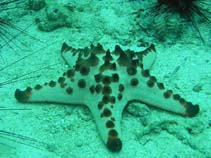Protoreaster nodosus (Linnaeus, 1758)
Horned sea star| Native range | All suitable habitat | Point map | Year 2050 |

|
| This map was computer-generated and has not yet been reviewed. |
| Protoreaster nodosus AquaMaps Data sources: GBIF OBIS |
Classification / Names Κοινά ονόματα | Συνώνυμα | CoL | ITIS | WoRMS
Asteroidea | Valvatida | Oreasteridae
Environment: milieu / climate zone / εύρος βάθους / distribution range Οικολογία
Υφαλόφιλο(α); εύρος βάθους 0 - 37 m (Αναφ. 89727). Tropical
Distribution Χώρες | Περιοχές FAO | Οικοσυστήματα | Παρουσίες | Εισαγωγές
Indo-West Pacific: from Seychelles to Australia and Japan.
Length at first maturity / Μέγεθος / Weight / Age
Γεννητική Ωρίμανση: Lm ? range ? - ? cm Max length : 30.0 cm WD αρσενικό/απροσδιόριστο; (Αναφ. 800)
Life cycle and mating behavior Γεννητική Ωρίμανση | Αναπαραγωγή | Γεννοβολία | Eggs | Γονιμότητα | Larvae
Main reference
Αναφορές | Συντονιστής | Συνεργάτες
Bos, A.R., G.S. Gumanao, J.C.E. Alipoyo and L.T. Cardona 2008 Population dynamics, reproduction and growth of Indo-Pacific horned star, Protoreaster nodosus (Echinodermata; Asteroidea). Marine Biology 156:55-63. (Αναφ. 89727)
IUCN Red List Status
(Αναφ. 130435: Version 2025-1)
CITES status (Αναφ. 108899)
CMS (Αναφ. 116361)
Threat to humans
Human uses
| FishSource |
Εργαλεία
Περισσότερες πληροφορίες
Διαδικτυακές πηγές
BHL | BOLD Systems | CISTI | DiscoverLife | FAO(Publication : search) | Fishipedia | GenBank (genome, nucleotide) | GloBI | Gomexsi | Google Books | Google Scholar | Google | PubMed | Δέντρο Ζωής | Wikipedia (Go, αναζήτηση) | Zoological Record



